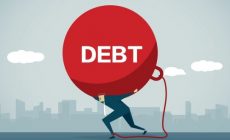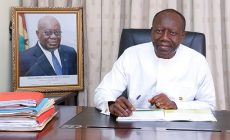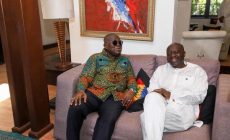Ghana’s public debt hits GH¢117.3 billion
- Posted on
- Comment
 GHANA’S public debt stock now stands at GH¢117.3 billion, Business Finder’s analysis of government’s borrowing in the last six months has revealed.
GHANA’S public debt stock now stands at GH¢117.3 billion, Business Finder’s analysis of government’s borrowing in the last six months has revealed.
The Bank of Ghana (BoG) in May this year published GH¢99.9billion as the country’s public debt level as at December 2015. Government however added about GH¢17.36billion to the debt stock by the end of the first quarter of 2016.
Meanwhile forecast from the Economist Intelligence Unit (EIU)has revealed that Ghana’s debt-to-GDP ratio will hit 75.8 per cent by the end of 2016 with a nominal Gross Domestic Product (GDP) of GH¢166.9billion up from GH¢139.9billion in 2015.
This means the country’s total public debt stock willhit GH¢126.6 billion by the end of this year.Further, the EIU is estimating a lower real GDP growth rate of 3.6 per cent, from the 5.2 per cent (non-oil) target in the 2016 budget.
It is worth stating that the projected 3.6 per cent growth in real GDP is lower than the 3.9 per cent achieved last year.
Analysts say this level of debt will undoubtedly increase Ghana’s already high risk of debt distress and further throw its fiscal consolidation programme out of gear.
Efforts to tame the fiscal deficit cannot yield the desired results if the country’s debt keeps rising.
After successfully cutting its fiscal deficit by more than three percentage points to 7.1 per cent of GDP in 2015, government’s 2016 budget aims to further reduce the fiscal deficit to 5.3 per cent of GDP but this will remain a mirage if the country’s debt is poorly managed and made to rise to the level projected by the EIU.
It is important to note that the 5.3 per cent deficit target was revised down from 5.8 per cent because of the high level of public debt and the significant financing constraints.
The International Monetary Fund (IMF), in April this yearexpressed concerns over Ghana’s deteriorating debt situation, stressing that “Ghana is at high risk of debt distress and faces exceptionally high gross financing needs.”
A high public debt level, even at GH¢117.3 billion means higher interest costs on capital raised on the international money market.
Indeed, it was the expectation of the IMF in its second review of the programme that Ghana’s debt level having peaked in December 2015 would begin to reduce in early 2016 but this has not happened.
“In terms of the path for debt, indeed debt remains very high, but we project it to go down gradually if the authorities continue with the fiscal effort that they have already started,” said AbdelhakSenhadji, Deputy Director of the Fiscal Affairs Department at the IMF.
Credit ratings agency Moody’s Investors Service has warned that reviewing Ghana’s credit worthiness to a better position will depend largely on how government is able to manage the public debt.
n a new report on Ghana, the agency said that Ghana’s current sovereign ratings reflect gross financing needs and a rising debt burden.
“Ghana’s B3 rating and negative outlook reflect the sovereign’s large gross financing needs, high debt burden and low debt affordability,” Moody’s observed.
Moody’s in its annual report maintained that: “Ghana’s gross financing needs are expected to reach 20% of GDP over the forecast horizon and the country is facing tight domestic and external funding conditions,” said Elisa Parisi-Capone, Vice President, Senior Analyst and co-author of the report.
“Ghana’s credit profile is also exposed to lower-for-longer commodity prices which weigh on the balance of payments and fiscal revenues,” Moody’s said.
Government has remained tight-lipped on the current size of the country’s public debt stock, fueling speculations of a deliberate agenda to refrain from public debateof the debt situation in the run-up to elections in November.
Analysts are unhappy about the silence of the Ministry of Finance and the BoG over the country’s debt situation and have called for full disclosure.
They found it interesting that BoG’s summary of macroeconomic and financial data released in March 2016,put Ghana’s public debt as at December 2015 at GH¢97.2 billion however data released in May prior to its monetary policy meeting revealed a revised debt stock of GH¢99.9billion. This reveals an increment of GH¢2.7billion, the source of which has not been explained.
Executive Director of the Institute for Fiscal Studies (IFS), Professor Newman Kusi is worried over the omission of information on the country’s debt situation in the Bank of Ghana’s Monetary Policy Committee data.
According to him, public debt management is partly a responsibility of the Bank of Ghana, being the banker to the government and the public institution that undertakes the selling of government bonds and supports the government to ensure their proper timing, stabilize their prices (interest rates) and minimize the cost of servicing public debt.
“This means that the Bank of Ghana should have complete information at all times on the public debt,” he said.
Even though the World Bank has projected Ghana’s real GDP growth to rebound to 5.2 per cent in 2016 from 3.4 per cent in 2015, on the back of expected stable energy supply and increased contribution from the oil and gas and agricultural industries, the target may not be met. This is due to the fact that the country has recently started experiencing erratic power outages.
Beyond the erratic supply of power, industry is bleeding profusely from high electricity and water tariffs and taxes.
By Isaac Aidoo










 (Selorm) |
(Selorm) |  (Nana Kwesi)
(Nana Kwesi)